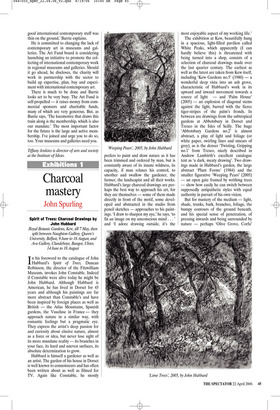Charcoal mastery
John Spurling
Spirit of Trees: Charcoal Drawings by John Hubbard Royal Botanic Gardens, Kew, till 7 May, then split between Naughton Gallery, Queen’s University, Belfast, 9 June to 18 August, and Ava Gallery, Clandeboye, Bangor, Ulster, 14 June to 18 August In his foreword to the catalogue of John Hubbard’s Spirit of Trees, Duncan Robinson, the director of the Fitzwilliam Museum, invokes John Constable. Indeed if Constable were alive today he might be John Hubbard. Although Hubbard is American, he has lived in Dorset for 45 years and although his paintings are far more abstract than Constable’s and have been inspired by foreign places as well as British — the Atlas Mountains, Spanish gardens, the Vaucluse in France — they approach nature in a similar way, with romantic feelings but a pragmatic eye. They express the artist’s deep passion for and curiosity about elusive nature, almost as a force or idea, but never lose sight of its more mundane reality — its branches in your face, its hard and uneven surfaces, its absolute determination to grow.
Hubbard is himself a gardener as well as an artist. The garden of his house in Dorset is well known to connoisseurs and has often been written about as well as filmed for TV. Again like Constable, he mostly ‘Weeping Pears’, 2005, by John Hubbard prefers to paint and draw nature as it has been trimmed and ordered by man, but is constantly aware of its innate wildness, its capacity, if man relaxes his control, to smother and swallow the gardener, the farmer, the landscapist and all their works. Hubbard’s large charcoal drawings are perhaps the best way to approach his art, for they are themselves — some of them made directly in front of the motif, some developed and abstracted in the studio from pencil sketches — approaches to his paintings. ‘I draw to sharpen my eye,’ he says, ‘to fix an image on my unconscious mind ... ’ and ‘I adore drawing outside, it’s the most enjoyable aspect of my working life.’ The exhibition at Kew, beautifully hung in a spacious, light-filled pavilion called White Peaks, which apparently (I can hardly believe this) is threatened with being turned into a shop, consists of a selection of charcoal drawings made over the last quarter century. The earliest as well as the latest are taken from Kew itself, including ‘Kew Gardens no.5’ (1980) — a wonderful deep vista into an ash grove, characteristic of Hubbard’s work in its upward and inward movement towards a source of light — and ‘Palm House’ (2005) — an explosion of diagonal stems against the light, barred with the fierce tiger-stripes of the palm’s fronds. In between are drawings from the subtropical gardens at Abbotsbury in Dorset and Tresco in the Isles of Scilly. The huge ‘Abbotsbury Gardens no.2’ is almost abstract, a play of light and foliage (or white paper, swirling lines and smears of grey), as is the denser ‘Twisting, Gripping no.1’ from Tresco, nicely described in Andrew Lambirth’s excellent catalogue text as ‘a dark, meaty drawing’. Two drawings made in Hubbard’s garden, the large abstract ‘Plant Forms’ (1984) and the smaller figurative ‘Weeping Pears’ (2005) — an open gate framed by writhing trees — show how easily he can switch between supposedly antipathetic styles with equal authority in pursuit of his own vision.
But for mastery of the medium — light, shade, trunks, bark, branches, foliage, the bumpy contours of the ground beneath, and his special sense of penetration, of pressing inwards and being surrounded by nature — perhaps ‘Olive Grove, Corfu’ (1994) is the most complete. And all executed, ladies and gentlemen, as if by nature itself, with mere sticks of charred wood! It’s a pity this show can’t be transferred to Tate Britain to coincide with the Constable exhibition at the beginning of June, though it wouldn’t look as good there as it does at Kew.



































































 Previous page
Previous page